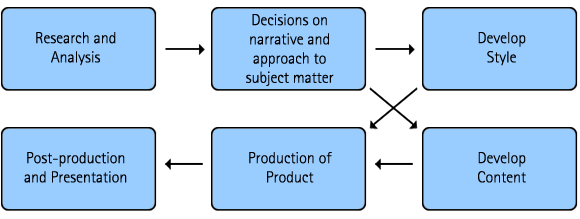Establishing content can be dependent on a number of factors:
- Suitability to the target audience
- Suitability to format
- Timescale
- Budget
- Speed of delivery
- Depth of information
- Selection of material available
- Order in which material is presented
- Purpose of the project (this drives selection)
- Market trends
- Length of material required
- Does it need to be easily updated?
- Who is producing the content

Style and Content should be developed simultaneously, and both
should feed into production.
The technology or techniques cannot compensate for absence of
content integrity or poor choice as these only help content to
serve its purpose more effectively. If working in an interactive
environment it is important to think about how this affects the
content and the way that it will be used as audiences have increasingly
high expectations.
Content, media format and techniques must be looked at holistically,
as they greatly affect each other.
It is vital to understand that interactivity places control in
the hands of the user, as they are able to consume the information
they are presented with at a time of their choosing and in their
order of preference. Content in a multimedia environment can have
no set beginning, middle or end. It is therefore vital that the
team have a thorough understanding of component parts and how
they interact as the user will able to move in numerous directions.
Content can be delivered in many forms, not necessarily text-based,
so it is important when creating this to think about:
- What material is relevant?
- What implications will user/audience choices have on material's
structure?
- Which media would best serve the purpose?
- How should material be organised so it is easily deciphered?
- Cohesion and integrity of the length and parts of content
need careful thought.
When working on a project the client may be responsible for the
content or a company may be commissioned to produce it. If the
client is producing the content it is important to test the strength
of the message you are trying to convey and research should uncover
what is irrelevant so this can be omitted.
- It is important to draw up a content agreement and keep full
control over sign off stages
- A client should be aware of the implications of changes and
revisions to content
- Ensure that the quality and relevance of content matches
the over all message
- The content may affect the ultimate design of the finished
product
- A design might be produced with a theme in mind and the content
then generated
The message of the content can be interpreted in terms of the
denotative message and the connotative message. The denotative
message is the literal message and the primary meaning. The connotative
message is the secondary meaning and it expands on communication
potential. The connotative meaning is conveyed by how something
is particularly designed, so it is important to think when writing
content what the message is.
Style and design
- A style can be imposed on a design by the designer or producer
- A style may be created especially for a particular client
or company
- A style may be determined by the client
- Style can influence the overall message
- The design can be influenced by cultural trends, social change,
political climate and history and this will in turn affect what
will be communicated to the audience or user
Content and form
The interdependence of form and content is crucial. Creative
visual thinking will determine the appropriate form for the subject
matter, but these must agree.
- The form needs to communicate the right message and this can
be expressed through colour, graphics, typeface and many other
elements
- It is possible to enhance meanings through design implication
and the viewer or user can then develop their own opinions about
the message being conveyed
- The colour, patterns or textures used in any design will
depend on the audience and the aim of the project
Different schools of thought have different arguments about the
relationship between form and content.
- Some believe the two are inseparable and that you cannot look
at one without the other
- Others believe the design or form is the message and that
the audience will therefore generally disregard the words
- Some believe that reading the text ensures viewers become
more involved in the content as they have to work harder to
absorb or understand the information
|

